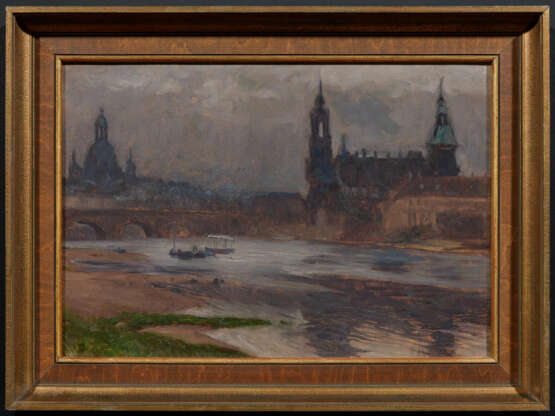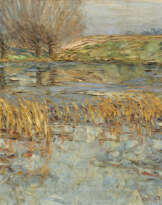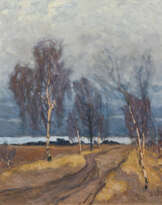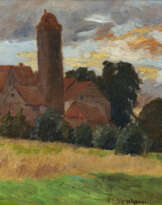ID 1319951
Lot 1384 | Otto Altenkirch. Dresden with Augustus Bridge. Small, grey atmosphere
Valeur estimée
€ 2 500 – 3 500
1875 Ziesar - 1945 Siebenlehn
Title:
"Dresden with Augustus Bridge. Small, grey atmosphere".
Date:
1902.
Technique:
Oil on card.
Measurement:
33 x 48.5cm.
Notation:
Monogrammed and dated lower right: "OA 02".
Frame:
Framed.
Signed and dated on verso: "Otto Altenkirch 1902.10.ph."
The present work, painted in April 1902 according to the catalogue raisonné, is the smaller version of the motif, which is listed there under the number 1902-11 with illustration.
Literature:
M. Petrasch: Otto Altenkirch, 1875 - 1945, Leben und Werk, Dresden 2005, p. 211, no. 1902.10-D (without ill.).
Provenance:
Private ownership, Germany.
Otto Altenkirch, a native of the Brandenburg province, begins his professional career in Berlin with an apprenticeship as a decorative painter, which he completes 'with honours'. From 1899, he studies painting at the Academy of Fine Arts in Berlin before transferring to the Dresden Art Academy with his teacher Eugen Bracht. There, Otto Altenkirch becomes Bracht's official assistant from 1903 and gains his first exhibition experience. After completing his studies, Altenkirch stays in Dresden as a freelance artist, but, in 1910, he also obtains a position there as a senior court theatre painter, which makes him independent of the art market. Otto Altenkirch works at the theatre for ten years and is awarded the title of professor for his services. In addition, he is always able to produce freely and take part in exhibitions. In 1920, the artist moves to the small town of Siebenlehn in central Saxony and concentrates entirely on landscape painting.
Three of Otto Altenkirch's works can be shown here:
The view of the city of Dresden from the right bank of the Elbe with the Hofkirche and the dome of the Frauenkirche was painted by the painter Bernardo Belotto (known as Canaletto) in the 18th century and since then this view of the city has been known as 'the Canaletto view'. Catalogue 1384 shows precisely this perspective of the city, albeit in a cool grey-blue-brown colour scheme. Only the green riverside meadow flashing up in the lower left-hand corner of the painting brings the shadowy, visionary view of the city into reality. The small-format work from 1902 is presumably a preparatory work for the later, larger version of the same theme (cat. rais. 1902-11-D).
Catalogue 1386 is a picture of the thaw. The first holes are appearing in the layer of ice in the mostly frozen river Mulde. Otto Altenkirch was fascinated by the contrast between the blue-black water and the white, grey and light blue winter colours of snow and ice. A few brown crumbs of earth peek out from under the snow and the brown reed grass stands dead on the bank. The far bank of the hollow has also thawed and appears as a slightly curved grey trace. The edge of the forest behind it is lost in wintry grey.
Otto Altenkirch was a committed open-air painter who also took his easel out into nature in winter and painted on location. The young painter created this picture in 1904 with a quick, impasto application of colour. The well-balanced framing and concentrated colours in this early work already reveal a confident maturity.
The autumnal golden birch trees from 1920 (catalogue 1385) are impressive. The extreme verticality of the trunks trimmed from the upper edge of the picture draws the viewer's gaze upwards, while at the same time the view through the centre of the picture draws it extremely into the depths. The impasto application of paint in short strokes corresponds to the tremulous flickering of the golden-yellow foliage, while the gaze comes to rest in the depths through long horizontal brushstrokes.
This particular motif must have particularly appealed to Otto Altenkirch as he painted it in several versions.
| Artiste: | Otto Altenkirch (1875 - 1945) |
|---|---|
| Technique appliquée: | Huile |
| Catégorie maison de vente aux enchères: | Peintures de maîtres récents |
| Artiste: | Otto Altenkirch (1875 - 1945) |
|---|---|
| Technique appliquée: | Huile |
| Catégorie maison de vente aux enchères: | Peintures de maîtres récents |
| Adresse de l'enchère |
VAN HAM Kunstauktionen GmbH Hitzelerstr. 2 50968 Köln Allemagne | ||||||||||||||
|---|---|---|---|---|---|---|---|---|---|---|---|---|---|---|---|
| Aperçu | |||||||||||||||
| Téléphone | +49 221 92586215 | ||||||||||||||
| Fax | +49 221 92 58 62 4 | ||||||||||||||
| Commission | 32% | ||||||||||||||
| Conditions d'utilisation | Conditions d'utilisation | ||||||||||||||
| Heures d'ouverture | Heures d'ouverture
|














